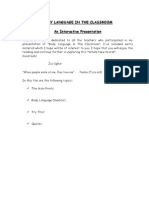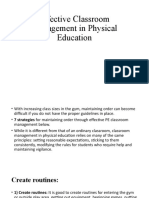100%(1)100% found this document useful (1 vote)
438 viewsLesson Plan Template
This document provides a template for lesson plans that includes sections for the lesson title, subject, grade level, rationale, learning outcomes, objectives, prerequisite skills, materials, activities, assessment, and reflections. The template is designed to guide teachers in planning lessons that clearly outline what students will learn and be able to do, how the lesson will be taught, and how learning will be evaluated. It also prompts teachers to consider how the lesson can be adapted for diverse learners and how classroom management strategies will be implemented.
Uploaded by
biffinCopyright
© © All Rights Reserved
Available Formats
Download as PDF, TXT or read online on Scribd
100%(1)100% found this document useful (1 vote)
438 viewsLesson Plan Template
This document provides a template for lesson plans that includes sections for the lesson title, subject, grade level, rationale, learning outcomes, objectives, prerequisite skills, materials, activities, assessment, and reflections. The template is designed to guide teachers in planning lessons that clearly outline what students will learn and be able to do, how the lesson will be taught, and how learning will be evaluated. It also prompts teachers to consider how the lesson can be adapted for diverse learners and how classroom management strategies will be implemented.
Uploaded by
biffinCopyright
© © All Rights Reserved
Available Formats
Download as PDF, TXT or read online on Scribd
You are on page 1/ 2
Page 1 of 2
LESSON PLAN TEMPLATE
Lesson Title:
Lesson # Date:
Name:
Subject:
Grade(s):
Rationale:
Prescribed Learning Outcome(s):
Instructional Objective(s):
Prerequisite Concepts and Skills:
Materials and Resources:
Teacher Students
Lesson Activities:
Teacher Activities Student Activities Time
Introduction (anticipatory set):
Body:
Closure:
Universal Design for Learning (UDL) and Differentiated Instruction (DI):
Organizational Strategies:
Behavioural Management Strategies:
Assessment and Evaluation:
Extensions:
Reflections (if necessary, continue on separate sheet):
Page 2 of 2
Lesson Plan Template EDPR 3100, 3200, 4100, 4200
The lesson plan template is designed as a guide for students to use when planning lessons. The plan may be adapted to specific subject
areas and modified as students gain experience in each practicum. The template is a basic outline that can be used directly as printed,
copied in longhand, or expanded from the electronic version. It is important that all areas required in the template are completed and
that the lesson plan be sufficiently clear and detailed so that another teacher could use the plan to teach the lesson.
Rationale: Why are you teaching this particular lesson (e.g. is it part of a complex skill? Is it an essential prereading skill in reading?
Is it important that the students hear good literature?) The rationale should be a brief sentence or two and stated in words that can be
easily understood by the children in the classroom.
Prescribed Learning Outcomes: The Integrated Resources Packages (IRPs) describe what students should be able to do in each
curricular subject. Your lesson should state one or more prescribed learning outcomes, from the curricula of British Columbia, on which
the objectives of this specific lesson are based.
Instructional Objective(s): What are the specific things students will be able to do as a result of this lesson? These objectives should
be consistent with your stated prescribed learning outcome(s) (e.g. the students will be able to identify the main idea in the story. The
student will be able to describe the main idea in a paragraph of four sentences). The objectives may also include things the teacher
wants to observe in the course of the lesson (e.g. to identify the potential leaders in group discussion). Students should ensure that the
instructional objectives are measured by your assessment and evaluation strategies.
Prerequisite Concepts and Skills: This section of your lesson plan is used to state the concepts and skills needed to connect lessons
together in a logical sequence, building new knowledge onto what you know students have previously learned. Remember that some
concepts and skills may need to be reviewed to ensure continuous learning, and these can be included here.
Materials and Resources: List all materials and resources that you and the students will need. What things do you need to do before
the lesson begins? (e.g. prepare a word chart.) What things do the students need to do? (e.g. read a chapter in the novel.)
Lesson Activities
Introduction: How will you get students interested in the topic? How will you find out what they already know about the topic? Will
you use an anticipatory set (link to their experience) or advance organizers?
Body: What sequence of activities will the student experience? What will you do? What will they do? What will children do who
finish early? How much time will each activity take? What about clean up?
Closure: How will you close the lesson? The closing should be linked to attaining your instructional objectives.
Universal Design for Learning (UDL) and Differentiated Instruction (DI): UDL includes: Multiple means of representation;
Multiple means of expression; and, Multiple means of engagement. DI is the process of ensuring that a students readiness level,
interests, and preferred mode of learning are recognized. Teachers can differentiate instruction in four ways: content, process, product,
and, learning environment based on the individual learner.
How will you accommodate your diverse learners? Consider learning styles and multiple intelligences. What are the individual needs
within this classroom and how will you accommodate them? What are the adaptations and modifications needed for students with
Individual Education Plans (IEPs)?
Organizational Strategies: Carefully thought-out organizational management strategies facilitate proactive positive classroom
management. For example, how will you : bring the class together at the start of the day/lesson?; utilize student helpers to facilitate the
flow of lessons and the day in general?; distribute and collect materials?; separate the class into groups or levels? (In what situations
should groups be assigned ahead of time?); coordinate different grade levels working on different assignments?
Behaviour Management Strategies: Carefully thought-out behaviour management strategies facilitate proactive positive classroom
management. What strategies will be used?
Assessment and Evaluation: Did the students learn what you taught them? The results of the assessment should be directly related to,
and tell you if, your students were able to do the things outlined in your instructional objectives and prescribed learning outcomes. Your
assessment should be as accurate as possible and should be built into your lesson. What rubrics or structures will you use t o evaluate
assessment data? Is assessment formative or summative? Include the assessment tool.
Extensions: How might this lesson link to previous and/or future lessons within the same curriculum area? How might knowledge, skills
or attitudes from this lesson be integrated/infused into lessons in other subject areas?
Reflections: Complete the reflections section as soon as possible after teaching the lesson. What revisions would you make to the
lesson? What went well?
You might also like
- Curriculum Standards - Workbook - Focus Group Standards PreliminaryNo ratings yetCurriculum Standards - Workbook - Focus Group Standards Preliminary3 pages
- Enhancing Professional Practice: A Framework For Teaching, 2nd Edition by Charlotte DanielsonNo ratings yetEnhancing Professional Practice: A Framework For Teaching, 2nd Edition by Charlotte Danielson26 pages
- Guidelines For Training of Trainers Education UNICEF Kit HandbookNo ratings yetGuidelines For Training of Trainers Education UNICEF Kit Handbook140 pages
- Effective Practices For Teaching English Language Learners A Resource Document For North Carolina's ELL Work GroupNo ratings yetEffective Practices For Teaching English Language Learners A Resource Document For North Carolina's ELL Work Group26 pages
- Supporting Students With Disabilities During School CrisesNo ratings yetSupporting Students With Disabilities During School Crises10 pages
- Curriculum Designing By: Rafael Jotojot JRNo ratings yetCurriculum Designing By: Rafael Jotojot JR34 pages
- Analytical Essay of A Physical Education Lesson Plan - Jonathan Fritsch 3No ratings yetAnalytical Essay of A Physical Education Lesson Plan - Jonathan Fritsch 315 pages
- Assure: Sharon Smaldino: About The ModelNo ratings yetAssure: Sharon Smaldino: About The Model2 pages
- Diagnosing Language Learning Difficulties and Problems: Ari PurnawanNo ratings yetDiagnosing Language Learning Difficulties and Problems: Ari Purnawan23 pages
- Class Delivery: Teaching Methodology ForNo ratings yetClass Delivery: Teaching Methodology For1 page
- 7 Effective Classroom Management in Physical Education 6No ratings yet7 Effective Classroom Management in Physical Education 610 pages
- Course No.: Ed 105 Descriptive Title: Facilitating Learning: CHAPTER I - MetacognitionNo ratings yetCourse No.: Ed 105 Descriptive Title: Facilitating Learning: CHAPTER I - Metacognition17 pages
- SIOP Lesson Template Topic, Class, and Level - Which Community Do You Prefer?, Writing, Grade 2100% (1)SIOP Lesson Template Topic, Class, and Level - Which Community Do You Prefer?, Writing, Grade 24 pages
- An Overview of Adult Learning Process PDFNo ratings yetAn Overview of Adult Learning Process PDF5 pages
- Burnes 2019 The Origins of Lewin S Three Step Model of ChangeNo ratings yetBurnes 2019 The Origins of Lewin S Three Step Model of Change28 pages
- Chapter 2 On Curriculum Development by Cariza FloresNo ratings yetChapter 2 On Curriculum Development by Cariza Flores4 pages
- Final Report - Priority Vocational SkillsNo ratings yetFinal Report - Priority Vocational Skills224 pages
- Brain-Based Learning and Its Implication in TeachingNo ratings yetBrain-Based Learning and Its Implication in Teaching8 pages
- World-Readiness Standards (General) + Language-specific document (CHINESE)From EverandWorld-Readiness Standards (General) + Language-specific document (CHINESE)No ratings yet
- Flower Structure and Reproduction Reading and QuestionsNo ratings yetFlower Structure and Reproduction Reading and Questions5 pages
- English Grammar Definite Article Special CasesNo ratings yetEnglish Grammar Definite Article Special Cases3 pages
- Esl Strategies: Scroll Down To See DescriptionsNo ratings yetEsl Strategies: Scroll Down To See Descriptions9 pages
- Past Perfect Tenses: Key Words: When, After, As Soon AsNo ratings yetPast Perfect Tenses: Key Words: When, After, As Soon As1 page
- Date Time Breath Hip Roll Normal Bridging: Abdominal Exercises For BeginnersNo ratings yetDate Time Breath Hip Roll Normal Bridging: Abdominal Exercises For Beginners3 pages
- Cabuyao Integrated National High School: The Problem and Its BackgroundNo ratings yetCabuyao Integrated National High School: The Problem and Its Background4 pages
- Choosing The Right Tools For Online Collaboration ToolsNo ratings yetChoosing The Right Tools For Online Collaboration Tools4 pages
- Professional Competence of English Language Teachers in UzbekistanNo ratings yetProfessional Competence of English Language Teachers in Uzbekistan5 pages
- University of Madras: Department of Counselling PsychologyNo ratings yetUniversity of Madras: Department of Counselling Psychology2 pages
- Journal Article Review - Sara Robledo LucasNo ratings yetJournal Article Review - Sara Robledo Lucas2 pages
- Supervising and Coaching Special Education Teachers - Ead 530 SPWNo ratings yetSupervising and Coaching Special Education Teachers - Ead 530 SPW5 pages
- Lesson Plan: Spanish Level 1, High School or Middle SchoolNo ratings yetLesson Plan: Spanish Level 1, High School or Middle School5 pages
- Work Immersion Module 4 Activities WorksheetNo ratings yetWork Immersion Module 4 Activities Worksheet4 pages
- Assessment of Employees Motivation and Its Effect On Organizational Performance (In Case of Commercial Bank of Ethiopia, Assosa Benishangull Branch)100% (1)Assessment of Employees Motivation and Its Effect On Organizational Performance (In Case of Commercial Bank of Ethiopia, Assosa Benishangull Branch)47 pages
- Pamantasan NG Lungsod NG Maynila: BackgroundNo ratings yetPamantasan NG Lungsod NG Maynila: Background5 pages
- Practicum Self Assessment - Heidi WippelNo ratings yetPracticum Self Assessment - Heidi Wippel4 pages
- Characteristics: Unsatisfactory Satisfactory Good ExcellentNo ratings yetCharacteristics: Unsatisfactory Satisfactory Good Excellent2 pages




















































































































